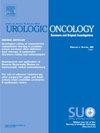DO THE METASTATIC PATTERNS OF SEMINOMA SUPPORT PRIMARY RPLND AS THE TREATMENT OF CHOICE IN STAGE II SEMINOMA COMPARED TO NON-SEMINOMA?
IF 2.4
3区 医学
Q3 ONCOLOGY
Urologic Oncology-seminars and Original Investigations
Pub Date : 2025-03-01
DOI:10.1016/j.urolonc.2024.12.092
引用次数: 0
Abstract
Introduction
Primary RPLND is one treatment modality for stage II seminoma germ cell tumor (SGCT) cases. In theory, the success of the procedure relies on having the disease confined within the dissected lymph nodes with no presence of any undetected organ metastatic disease outside the surgical margins. While SGCT characteristics and behavior have been well described in comparison to non-seminoma germ cell tumors (NSGCT), quantifying the probability and absolute causal effect of SGCT subtype in having advanced metastatic disease (i.e., Stage III) compared to NSGCT has not been described using large national dataset yet. Therefore, we aim to quantify and describe this relationship using the National Cancer Database (NCDB).
Methods
We utilized inverse propensity score weights (IPTW) calculated by age, primary tumor characteristics, patient sociodemographic, regional and facility level, and year of diagnosis to run a multivariable IPTW-weighted logistic regression model (MVA) for the outcome of stage III (vs. stage I/II) to estimate the odds ratio of SGCT presenting with stage III. Then, we utilized IPTW to estimate the absolute average causal effect of SGCT v.s. NSGCT in developing stage III in our balanced IPTW-matched study sample.
Results
We identified 62,329 testicular germ call cancer patients between 2004 and 2016 (details available in Table 1). Our IPTW-MVA showed that SGCT is significantly less likely to present with stage III disease compared to NSGCT after accounting for all available covariates (OR: 0.303, [95%CI; 0.278 – 0.330], p<0.0001), based of the same model we estimated the mean causal effect of presenting as stage III to be significantly less likely in SGCT compared to NSGCT by 66.41% if all other patients parameters and variables were the same (- 62.41% [95%CI: - 65.00%, -59.82%], p<0.0001).
Conclusions
Our results strongly validate the use of primary-RPLND in SGCT as opposed to NSGCT, as SGCT are 62.41% less likely to present with advanced stage given the same parameters in NSGCT. In addition torecent favorable clinical trial results, primary RPLND in carefully selected SGCT patients should be highly considered to avoid long-term complications associated with other treatment modalities.
与非精原细胞瘤相比,精原细胞瘤的转移模式是否支持将原发性RPLND作为ii期精原细胞瘤的治疗选择?
原发性RPLND是II期精原细胞瘤生殖细胞瘤(SGCT)的一种治疗方式。理论上,手术的成功依赖于将疾病限制在清扫的淋巴结内,并且在手术边缘外不存在任何未被发现的器官转移性疾病。虽然与非精原细胞瘤生殖细胞肿瘤(NSGCT)相比,SGCT的特征和行为已经得到了很好的描述,但与NSGCT相比,SGCT亚型在晚期转移性疾病(即III期)中的量化概率和绝对因果效应尚未使用大型国家数据集进行描述。因此,我们的目标是使用国家癌症数据库(NCDB)来量化和描述这种关系。方法利用年龄、原发肿瘤特征、患者社会人口统计学、地区和设施水平以及诊断年份计算的逆倾向评分权重(IPTW),运行多变量IPTW加权logistic回归模型(MVA),计算III期结局(与I/II期相比),以估计SGCT出现III期的优势比。然后,在平衡的IPTW匹配的研究样本中,我们利用IPTW来估计SGCT与NSGCT在发展第三阶段的绝对平均因果效应。我们在2004年至2016年期间确定了62,329例睾丸生殖细胞癌患者(详细信息见表1)。我们的IPTW-MVA显示,在考虑了所有可用的变量后,SGCT出现III期疾病的可能性明显低于NSGCT (OR: 0.303, [95%CI;0.278 - 0.330], p<0.0001),基于相同的模型,我们估计在所有其他患者参数和变量相同的情况下,SGCT中表现为III期的平均因果效应比NSGCT低66.41% (- 62.41% [95%CI: - 65.00%, -59.82%], p<0.0001)。结论与NSGCT相比,我们的研究结果有力地验证了原发性rplnd在SGCT中的应用,因为在NSGCT相同的参数下,SGCT出现晚期的可能性要低62.41%。除了最近良好的临床试验结果外,应高度考虑精心挑选的SGCT患者的原发性RPLND,以避免与其他治疗方式相关的长期并发症。
本文章由计算机程序翻译,如有差异,请以英文原文为准。
求助全文
约1分钟内获得全文
求助全文
来源期刊
CiteScore
4.80
自引率
3.70%
发文量
297
审稿时长
7.6 weeks
期刊介绍:
Urologic Oncology: Seminars and Original Investigations is the official journal of the Society of Urologic Oncology. The journal publishes practical, timely, and relevant clinical and basic science research articles which address any aspect of urologic oncology. Each issue comprises original research, news and topics, survey articles providing short commentaries on other important articles in the urologic oncology literature, and reviews including an in-depth Seminar examining a specific clinical dilemma. The journal periodically publishes supplement issues devoted to areas of current interest to the urologic oncology community. Articles published are of interest to researchers and the clinicians involved in the practice of urologic oncology including urologists, oncologists, and radiologists.

 求助内容:
求助内容: 应助结果提醒方式:
应助结果提醒方式:


